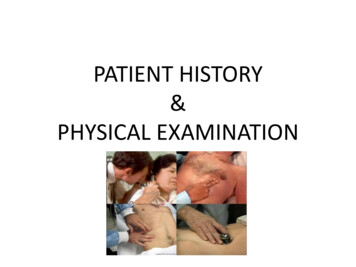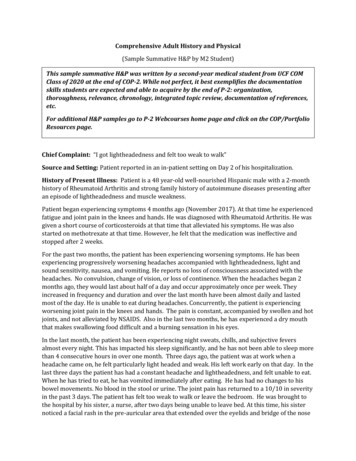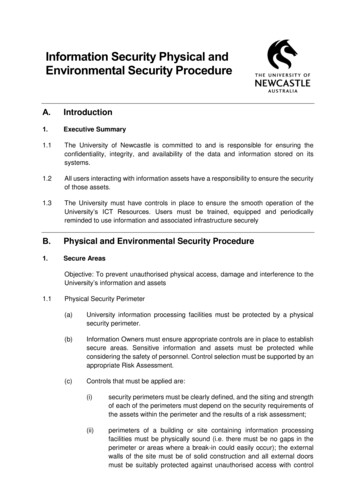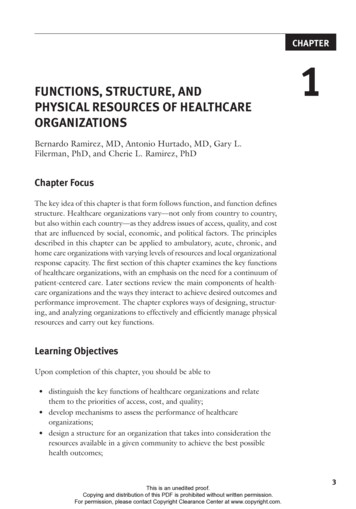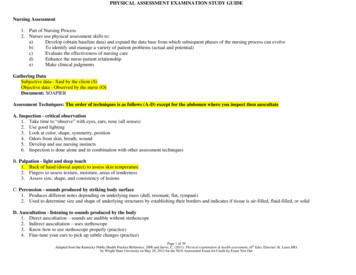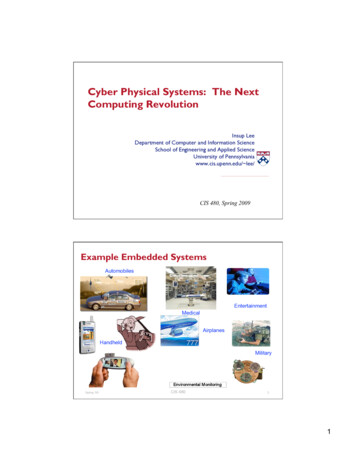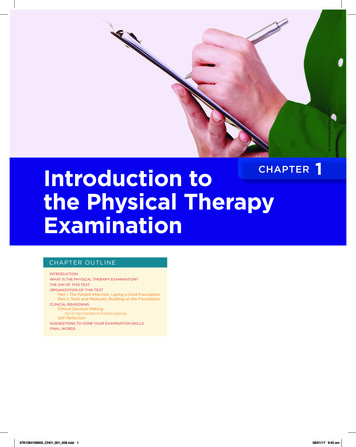
Transcription
Robert Kneschke/ShutterStock, Inc.CHAPTERIntroduction tothe Physical TherapyExamination1C HA P T ER OU T LINEINTRODUCTIONWHAT IS THE PHYSICAL THERAPY EXAMINATION?THE AIM OF THIS TEXTORGANIZATION OF THIS TEXTPart I. The Patient Interview: Laying a Solid FoundationPart II. Tests and Measures: Building on the FoundationCLINICAL REASONINGClinical Decision MakingUse of Case Examples to Enhance LearningSelf-ReflectionSUGGESTIONS TO HONE YOUR EXAMINATION SKILLSFINAL WORDS9781284108859 CH01 001 008.indd 109/01/17 9:45 am
2CHAPTER 1Introduction to the Physical Therapy ExaminationIntroductionWelcome to one of the most dynamic, challenging, and rewarding professions you could have chosento study—physical therapy! You have every reason to be excited. Yes, you may have some apprehension,self-doubt, or even anxiety, all of which are quite normal, but a healthy dose of excitement is encouraged.If you are just beginning this journey, you will be amazed at how much there is to learn. You must have athorough understanding of anatomy and neuroscience; you must grasp the intricacies of physiology andpathophysiology; you must appreciate human movement and biomechanics; you must be aware that yourpatients have emotional, social, vocational, and spiritual facets they will bring with them in addition totheir physical concerns; you must have some understanding of the convoluted and ever-changing healthcare system, including aspects of insurance, billing, and diagnostic codes; and you must appreciate thelegal, ethical, and moral components that go into daily clinical decisions. While that may sound incredibly daunting, the immense responsibilities you will have to your patients and to your profession requiresubstantial breadth and depth of both knowledge and skills.This text uses terminology and concepts that are consistent with the Guide to Physical Therapist Practice 3.0 (theGuide).1 However, for ease of reading, the term “patient/client” has been modified to “patient” throughout this text.While physical therapists see both patients and clients,1 thistext focuses on the examination process that would be mostfrequently conducted with a patient (see BOX 1-1).WHAT IS THE PHYSIcALTHERAPY EXAMINATION?At the core of each new patient encounter in any physicaltherapy setting is the patient examination. This is the firstcomponent in a cycle that encompasses the entire physicaltherapy episode of care (see FIGURE 1-1).The patient examination consists of (1) the patienthistory, (2) a systems review, and (3) tests and measures.1The patient history typically involves a verbal interviewin which information relevant to the patient’s conditionBOX 1-1Patient versus clientThe term “patient” typically refers toindividuals with a disease, condition,impairment, or disability who receive physicaltherapy examination, evaluation (includingdiagnosis and prognosis), and intervention.The term “client” typically refers toindividuals who seek physical therapy servicesfor consultation, professional advice, healthpromotion and wellness, or preventativeservices.From: The Guide to Physical Therapist Practice 3.019781284108859 CH01 001 008.indd 2is gathered. During this interview, a clinician begins toformulate hypotheses about the patient’s condition. Asystems review is a brief assessment of the cardiovascular/pulmonary, integumentary, musculoskeletal, and neuromuscular systems as well as the patient’s cognitive, language, and learning abilities. The physical therapist thenselects tests and measures based on hypotheses formedduring the history-taking process and findings during thesystems review. Data from tests and measures are used tosupport or refute the clinician’s theories until one or morepredominant hypotheses remain.The evaluation process requires synthesis of all datacollected during the examination and helps to answer thequestion “What does it all mean?” Diagnosis and prognosisare actually two specific subfactors within the evaluationprocess. Determination of a patient’s physical therapy diagnosis requires an answer to the question “Into what clinicalpattern does the patient’s presentation fall?” The physicaltherapy diagnosis is a label that describes a cluster of signsand symptoms typically associated with a disorder or syndrome leading to impairments, activity limitations, or participation restrictions.2 This diagnosis guides the physicaltherapist in determining appropriate intervention strategiesfor each patient. Formulating a prognosis for the patientasks the question “What is the patient’s expected level offunctional improvement based on all influential factors(including biological, psychological, and social)?” Becauseanswers to these questions often rely on some degree ofclinical experience, the evaluation, diagnosis, and prognosis portions of the patient management process are oftendifficult for students to grasp in the early phases of learning.The intervention and outcomes components of themodel are relatively self-explanatory. Interventions areselected and implemented based on findings from theexamination and evaluation and may include things suchas therapeutic exercise, functional training, training in selfcare, and patient instruction. Outcomes are the results of the09/01/17 9:45 am
The Aim of this Text3Examination History Systems review Tests & measuresManagement Plan of care Coordination &communication Documentation Ongoing assessmentEvaluation Interpret response totests & measures Synthesize all data Diagnosis PrognosisOutcomesInterventionFIGURE 1-1 The patient management model for physical therapists.interventions that can be assessed periodically during or atthe end of an episode of care.Global management of this model occurs throughoutthe process and includes creating and modifying (as needed)the patient’s plan of care; coordinating, communicating, anddocumenting the plan of care, involving other providers asneeded; and making an ongoing assessment of the patient’sstatus and the efficacy of the care plan.1As might be discerned from the model, the entire process is dynamic, flexible, and interrelated. Because numerous factors can influence any component of this model atany point during the episode of care, this process is rarelylinear. When changes occur within any component, theother components often require adjustment. The reader isreferred to the Guide1 for more detailed information specific to processes beyond examination within the patientmanagement model.The following analogy, which likens the patient evaluation and management system to the construction of a house,illustrates the importance of the initial patient examination as the basis for all that follows (see FIGURE 1-2). Thefirst step in house construction is laying the foundation.Whether attempting to build a house of cards, a house oftoothpicks, or an actual house, if the foundation is not solidand secure, the structure on top will crumble. In terms ofpatient management, the initial patient interview possessesthe same level of importance as the foundation of the house.THE AIM OF THIS TEXTThis text focuses on the first part of the patient evaluationand management system: the patient examination. Physicaltherapists are required to perform an examination on everypatient prior to initiating any form of intervention.1 If theexamination is thoughtful, purposeful, skilled, and efficient,forming evaluative opinions and making decisions about apatient’s care plan should not be difficult. If the examination is lacking in quality or substance, then the evaluation,care plan, and possibly the patient’s outcomes may suffer.Thus, the purpose of this text is to provide you with thefundamental skills required to conduct an efficient, effective, and meaningful physical therapy examination with awide variety of patient types that may be encountered in anumber of different clinical settings.9781284108859 CH01 001 008.indd 3ationmInforfrom tests and measuresFIGURE 1-2 Consider the patient examination analogousto the process of building a house.09/01/17 9:45 am
4CHAPTER 1Introduction to the Physical Therapy ExaminationMany factors contribute to a successful patient interview.The strength of the foundation will rely not only on thepatient’s answers to your questions but also on the rapportand trust you develop with the patient, the atmosphere youestablish, your professional appearance and demeanor, andyour ability to adjust to the patient’s spoken and unspokenneeds.Once a solid foundation has been established, theframework of the house can be built. The framework mustbe well planned and skillfully constructed. In relation topatient management, the tests and measures portion ofthe examination creates this framework. A patient with astraightforward and uncomplicated condition may requirevery few tests and measures (the house will have a singlestory and few rooms); a patient with a difficult or complicated condition may require many tests and measures thatexamine a number of different body systems (the house willhave several stories and many rooms).A solid foundation and sturdy framework provide thenecessary structure for all components that remain. It is thepurpose of this text to provide you with the skills to createthat basic but valuable structure. Advanced courses, combined with clinical experience, will provide you with thetools to finish the construction: the evaluation, diagnosis,prognosis, and care management plan.ORGANIZATION OF THISTEXTAlthough obtaining the patient’s history in his or herown words is one component of the initial interview, theprocess is much broader than that. Chapters 2 and 3 coveressential aspects of the initial interview that are unrelatedto the specific questions that may be asked. These includethe safe and inviting atmosphere you are responsible forcreating, the rapport you establish with the patient, biopsychosocial and cultural aspects that must be considered,recognition of judgments or stereotypes you may possess,the communication techniques you use, and the importanceof recognizing nonverbal cues (the patient’s and your own).Chapter 4 discusses both the conduct and content of theinterview itself. This includes an introduction to red andyellow flags (concerning findings that may prompt referralto another health care provider); the importance of observation, which begins the first moment you see the patientand continues throughout the encounter; how to greet thepatient and introduce yourself; and a detailed outline of categorical questions you may choose to ask.Part II. Tests and Measures:Building on the FoundationChapter 5 provides an introduction to the remaining chapters of this text. These chapters (6–10) contain informationabout a wide variety of tests and measures, generally organized by the type of condition for which each test/measurewould be most appropriate.This text is separated into two parts: Part I describes allaspects related to the initial patient interview, and Part IIdescribes a myriad of tests and measures that can be usedwith a wide variety of patient conditions.Part I. The Patient Interview:Laying a Solid FoundationChapters 2 through 4 discuss various aspects of the initialpatient interview, also considered the subjective history orpatient history.Realize that many tests/measures are quite appropriateto use for a variety of conditions that cross body systems.Balance problems, for example, are certainly not isolatedto individuals who have a neuromuscular condition; thus,physical therapists should have a solid understanding ofwhen and how to assess a patient’s balance regardless ofclinical setting. Similarly, considering the alarmingly highnumber of individuals who have hypertension (33% of theU.S. population3), physical therapists working in any setting should be prepared to assess a patient’s cardiovascular9781284108859 CH01 001 008.indd 409/01/17 9:45 am
Clinical Reasoningsystem. This highlights the author’s primary rationale forpresenting content based on particular tests/measures asopposed to affected body region or specific patient condition. If you can understand (1) the fundamental conceptsthat form the basis for each test/measure, (2) the techniquesof performing each test/measure, and (3) when it is and isnot appropriate to use each test/measure, then you willhave a broad repertoire of assessment tools at your disposalthat can be utilized with patients regardless of body regionaffected or presenting condition.One of the most challenging aspects of learning thepatient examination process, considering both the patientinterview and tests/measures, relates to the “When?” question. Understanding when to utilize a line of questioningor a particular test/measure, and then making sense ofthe findings, is fundamentally more challenging than theskill required to ask the questions or perform a given test/measure. For this reason, information about when a particular assessment tool would be considered a priority and whenit might not is consistently included throughout the text.cLINIcAL REASONINGclinical Decision MakingMaking decisions about whether to ask a question duringthe initial interview or to perform a particular test during the physical examination is the beginning of clinicalBOX 1-25reasoning. Research in the area of clinical reasoning suggests that what separates expert from novice clinicians is theability to apply knowledge and skill, in conjunction with theability to intuitively alter the examination or interventionbased on self-reflection, prior experience, and individualpatient characteristics.4–6 Knowledge and skills that fosterbasic clinical decision making can be learned in the classroom setting; clinical intuition and understanding how individual patient characteristics may influence each encounterare critical components that must develop over time.Clinical reasoning requires collaboration between thephysical therapist and the patient.4 Clinical reasoning isused as the data are being collected from the patient, notsimply af
tive, and meaningful physical therapy examination with a wide variety of patient types that may be encountered in a number of different clinical settings. Th e following analogy, which likens the patient evalua-tion and management system to the construction of a house, illustrates the importance of the initial patient examina-tion as the basis for all that follows (see FIGURE 1-2 Th. e ) first .

